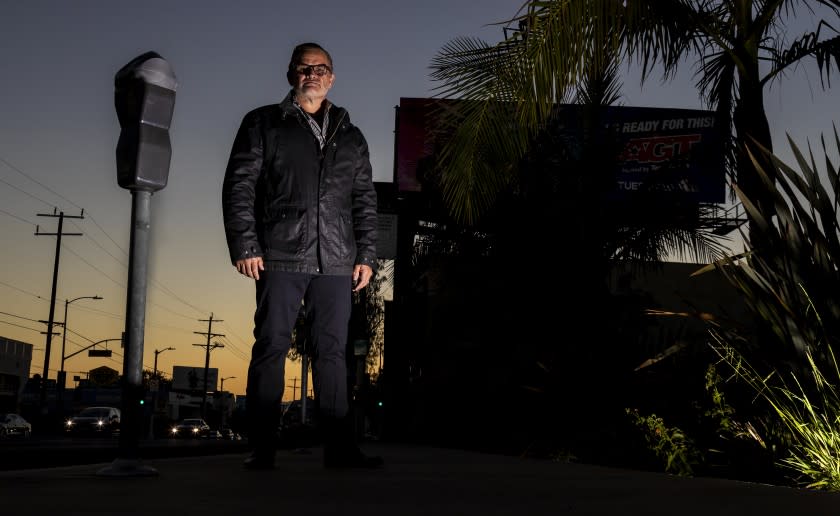Protester charged with assaulting LAPD officer moments before he was wounded by projectile

A protester who is suing the city of Los Angeles and several LAPD officers after being shot and badly wounded by a police projectile during a major protest in the city this summer has been charged with assault in the same incident.
Bradley Steyn, 49, was charged with assaulting an officer and resisting or obstructing an officer in a misdemeanor complaint filed in California Superior Court by City Atty. Mike Feuer's office Monday, court records show. The complaint alleges Steyn "willfully and unlawfully [used] force and violence" against an LAPD officer — identified only as Officer K. Clark — during a protest in the Fairfax district on May 30.
The underlying encounter is one that has garnered attention for months, first after Steyn began sharing his experience of being shot and rushed into emergency surgery for a ruptured testicle, and later as the LAPD released body camera video showing him lunging forward in an apparent attempt to kick an officer on the skirmish line in the moments before he was shot.
Police and their supporters pointed to the incident as an example of the violence that police face during such events, and have suggested that Steyn's allegedly kicking the officer gave the second officer cause to see him as a threat and to shoot him.
Steyn and his supporters, meanwhile, have said the decision by police to shoot him at close range with a projectile represented excessive force. Steyn, a famed anti-apartheid activist and former spy for Nelson Mandela's party in South Africa who now lives outside L.A., said he also was struck across the chest with a baton.
Jerod Gunsberg, Steyn's attorney, said Monday that the new criminal case — filed by the city after Steyn sued the city — "certainly looks like retaliation."
He also criticized the way in which the LAPD has been selectively releasing evidence in the case, including body camera video.
"The only evidence we have seen so far is a 17-minute-long and heavily edited video of the incident which the LAPD inexplicably uploaded to YouTube. They did this long before charges were filed," Gunsberg said. "We know there is plenty of evidence out there that tells the full and true story of what happened that day. We look forward to the city disclosing this evidence and we look forward to fighting this case."
Lisa Bloom, Steyn's attorney in his civil case against the city, also alleged retaliation.
"The city attorney's office obviously has a conflict, and these charges were clearly filed in retaliation for the filing of our civil case and because Bradley has been outspoken about the police brutality he witnessed at the Black Lives Matter protest," she said Monday.
Feuer's office said the charges against Steyn were "completely unrelated" to his lawsuit, but otherwise declined to comment on the case beyond its filing.
The LAPD has previously said that its investigators reviewed the incident, believed that Steyn had assaulted an officer, and referred the matter to Dist. Atty. Jackie Lacey's office — who forwarded it on to Feuer's office. A department spokesman said Monday that he could not immediately comment on the new charges.
Steyn, a South African-born mass-shooting survivor and coauthor of a book about his days spying for the African National Congress, referred questions Monday to Gunsberg. However, in a previous interview, he told The Times that he could see the eyes of the unidentified officer who shot him, and believed the officer "was not aiming for my center body mass or my belt buckle" but "trying to put the hurt on."
LAPD policy requires officers fire the sort of projectile that struck Steyn only at targeted individuals' belt lines, and only when they represent a threat to officers or others in the crowd.
In the body camera video, which was released in August, Steyn is seen standing near the front of a crowd of protesters, directly opposite a skirmish line of officers, as officers scream for the protesters to leave the area.
“Shut the f— up,” Steyn responded, before accusing officers at the scene of using excessive force.
After another man passing along the skirmish line gets shoved by an officer with a baton, Steyn and others in the crowd get visibly upset, and Steyn then lunges forward with his foot in the air. In his interview with The Times, Steyn said he was trying to defend the man who had been shoved.
Video from the camera of the officer who shot Steyn shows that officer then acknowledge the kick and his shooting Steyn.
“Fired another round. Male, white, kicked Officer Rivera,” the officer says.
A separate internal LAPD review to determine whether the officer who shot Steyn was justified in doing so remains open.
Bloom said in an interview this summer that it was clear from the video that Steyn was defending the other man.
“It’s obvious even from the edited video that the police officer struck a peaceful unarmed Black man walking by, simply talking on the phone, just before this incident," Bloom said in August. "Many protesters, in addition to Mr. Steyn, reacted to that act of police brutality.”
In his lawsuit, Steyn claims he lost a lot of blood and fell unconscious after he was shot. He later made it to Cedars-Sinai Medical Center, where he underwent surgery. In his interview with The Times, Steyn said he had moved toward the skirmish line after seeing young people fleeing from officers firing tactical rounds.
He said the scene had reminded him of the Strijdom Square massacre — a mass killing by a racist white gunman that Steyn witnessed in Pretoria, South Africa, as a 17-year-old boy — and triggered post-traumatic stress in him.
This story originally appeared in Los Angeles Times.

